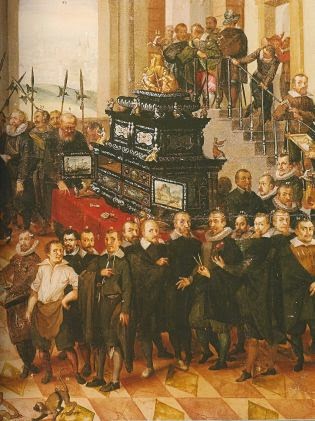Cabinet of Curiosities
"Accumulation, definition, classification - such was the three fold aim of the earliest cabinet of curiosities." (1)

Early Museums
Cabinet of Curiosity (or Curiosities) came into popular use starting in 15th century Renaissance Europe. They were originally rooms filled with all type of objects from nature, from antiquity, and from the art world. Eventually these collections would be stored in elaborately modeled cabinets, full of drawers and shelves of different sizes and shapes.
Today's modern furniture analogy would be a curio cabinet. Very large cabinets of curiosities, with massive numbers of specimens, eventually became the base collection for many of the world's great public museums. Physicians, merchants, nobility, and royalty were the many kinds of citizens that would collect and build cabinets to display their collections.
 In Germany in 1550, Kunstkammer ("Chamber of Art") was 1st used to describe these collections. Also used was Wunderkammer ("Collection of Marvelous Things") to describe collections more populated by objects from the natural word, such as fossils, mineral formations, and animal and plant specimens. Eventually the two words were joined and were used as Kunst-und Wunderkammer ("Cabinets of Art and Wonder"). Cabinets became increasingly popular as the printing press came into wide usage (allowing publication of catalogues displaying all of a collector's unique treasures). The newly expanding mercantile class, benefitting from New World trade, provided wealth to purchase items from around the world. Expeditions to North and South America, Asia, and Africa sent many ships back to Europe full of natural history merchandise for collectors.
In Germany in 1550, Kunstkammer ("Chamber of Art") was 1st used to describe these collections. Also used was Wunderkammer ("Collection of Marvelous Things") to describe collections more populated by objects from the natural word, such as fossils, mineral formations, and animal and plant specimens. Eventually the two words were joined and were used as Kunst-und Wunderkammer ("Cabinets of Art and Wonder"). Cabinets became increasingly popular as the printing press came into wide usage (allowing publication of catalogues displaying all of a collector's unique treasures). The newly expanding mercantile class, benefitting from New World trade, provided wealth to purchase items from around the world. Expeditions to North and South America, Asia, and Africa sent many ships back to Europe full of natural history merchandise for collectors.Wealth of Knowledge
Many of the world's great natural history museums had their beginning in the cabinet of curiosity collections of private individuals. The famous cabinet of Parisian Joseph Bonnier de la Mosson (1707-1744) was acquired by Georges-Louis Leclerc, Comte de Buffon (1707–1788 AD),
for the Muséum National d'Histoire Naturelle located in the Jardin des Plantes in Paris.
In Oxford, the Ashmolean Museum was built in 1683 to house the collection of botanist John Tradescant (1577-1638 AD). In the last years of Tradescant's life, he opened his collection to the public. At his death his son and Elias Ashmole (1617-1692 AD), expanded and catalogued his
collection.
The British Museum began with the collection of Sir Hans Sloane. The British museum was the first national, secular museum open to the general public. Over time more rigorous academic standards were applied to the museum's collection with the specimens becoming less of a cabinet of curiosity. Due to Sloane's painstaking attention to cataloguing, his collection already had a widely acknowledged scientific value. Unfortunately, not all the collections which the museum acquired were as meticulously researched.
"Somewhat to the trustees relief the medical and anatomical specimens, including the monsters, were transferred to the Hunterian Museum." (6)
Wealth of Knowledge
 Not only did wealthy merchants and the nobility succumb to the collecting passion, but so did many royalty. Although most royal collections concentrated on antiquities and works of art, many were well stocked with natural history objects. Rulers used the Kunst-und Wunderkammers to demonstrate imperial magnificence, power, and wealth.
Not only did wealthy merchants and the nobility succumb to the collecting passion, but so did many royalty. Although most royal collections concentrated on antiquities and works of art, many were well stocked with natural history objects. Rulers used the Kunst-und Wunderkammers to demonstrate imperial magnificence, power, and wealth.
"Curiosities were the pride and joy of the nobility and small fortunes were spent amassing collections." (3)
Francesco I of Tuscany, Charles I Of England, Frederick III of Denmark, Peter the Great of Russia, Rudolph II, Holy Roman Emperor -- all collected and established dynastic cabinets of curiosities. Even the Vatican developed a large collection overseen by Michele Mercati (1541-93) for Pope Sixtus V. The collection was made up of fossils, prehistoric tools, and mineral formations.
In Germany, at the Hapsburg court of Austria, collecting was reserved for kings and princes only. In other parts of Europe, the cabinet collection craze peaked in the 18th century. Paris had 17 private collections in 1742, 21 in 1757, and 60 by 1780. All of these collections, both private and princely, engaged collecting agents around the world to send unique and distinctive items to their collections.
"Over the course of centuries intrepid naturalists shipped many boat loads of stuffed, pressed, pickled, and live plants and animals across the Atlantic to fill the 'cabinets of curiosity' in noble homes and the collections of early museums." (4)
References
Accumulatus, Cabinet of Curiosity, viewed 30 June 2014, from http://www.accumulatus.com/cabinet.php


No comments:
Post a Comment